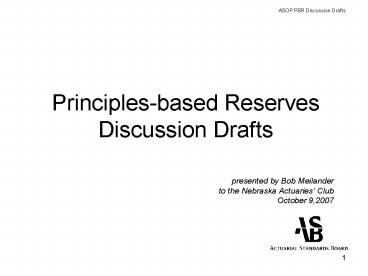Principlesbased Reserves Discussion Drafts PowerPoint PPT Presentation
1 / 19
Title: Principlesbased Reserves Discussion Drafts
1
Principles-based ReservesDiscussion Drafts
- presented by Bob Meilander
- to the Nebraska Actuaries Club
- October 9,2007
2
Principles-based Reserves Discussion Drafts
- Progress has been made
- Two drafts in progress
- PBR Task Force (considering calculation)
- Chaired by Frank Irish
- Working since December, 2005
- Discussion Draft as of May 8, 2007
- Principles-based Review
- Chaired by Charles Carroll
- Working since October, 2006
- Discussion Draft as of May 8, 2007
3
Principles-based Reserves Discussion Drafts
- Discussion drafts have been developed
- Each is an illustration of what might be done
- Not reviewed or approved by the ASB
- Not an Exposure Draft
- Based on current state of proposals
- Works in progress!
4
PBR Task Forces
Actuarial Standards Board
Life Operating Committee
Other Operating Committee
Other Operating Committee
PBR Task Force
Other Task Force
PBR Review Task Force
5
Next Steps
- Develop Exposure Draft
- Revised by LOC and ASB
- Expose to actuarial profession for comment
- Revise to reflect comments
- Approved by LOC and ASB
- Final standard
6
Intent
- Provide guidance to actuaries doing
principles-based valuation - Dovetail with Valuation Manual
- Currently there is some overlap
- Not a substitute for state regulation
7
PBA CalculationStructure
- Section 1 Purpose, Scope, Cross References, and
Effective Date - Scope related to Model Regulation
- Section 2 Definitions
- Of key terms
- In many cases these follow from the Model
8
PBA CalculationStructure (cont.)
- Section 3 Analysis of Issues and Recommended
Practices - Regulatory Requirements
- Qualified Actuary
- Cash Flow Models
- Anticipated Experience
- Determining Assumption Margins
- Reliance, Documentation
9
PBA CalculationStructure (cont.)
- Section 4 Communication and Disclosure
- Actuarial Communications
- Certification and Actuarial Report
- Reliance on Others
- Conflict with Applicable Law, Retention, and
Deviation from Standard
10
PBA CalculationStructure (cont.)
- Appendix
- Will include sections on
- Background
- Current Practices
11
Example
In establishing the anticipated spreads over
Treasuries for the purchase of reinvested assets,
the actuary should consider the companys current
investment strategy for the block of business and
whether the reinvestment assets will be
consistent with the types, quality and maturities
of assets in the companys current investment
strategy. For example, the current investment
strategy may also relate to matching the duration
of assets and liabilities over time. In that
case, the maturities of future reinvestment
assets may be different from the current strategy
regarding maturities.
Section 3.4.2.c.
12
Example
Expense InflationThe actuary should consider
whether unit costs (particularly those other than
direct sales expenses and taxes, licenses, and
fees) ought to be treated in the projection as
subject to inflation. Applicable law may require
such an assumption. Possible sources of
information about inflation assumptions are
published projections of the CPI or the price
deflator, such as the rate selected by the Social
Security Administration for its long-term
intermediate projection. The actuary may also
wish to assume that future inflation rates will
vary if prevailing new-money rates change. The
resulting projection of implied real return
should be reviewed by the actuary for
reasonability.
Section 3.4.4.a.
13
PBA ReviewStructure
- Section 1 Purpose, Scope, Cross References, and
Effective Date - Scope related to Model Regulation
- Section 2 Definitions
- Of key terms
- In many cases these follow from the Model
14
PBA ReviewStructure (cont.)
- Section 3 Analysis of Issues and Recommended
Practices - General, Regulatory Requirements, Appointment and
Qualifications - Understanding, Evaluating Company Risks
- Methods, Models, Assumptions, Margins
- Relationship with Regulators, Certifying Actuary
- Additional Data and Analysis, Opinion
- Reliance and Documentation
15
PBA ReviewStructure (cont.)
- Section 4 Communication and Disclosure
- PBA Review Opinion
- PBA Review Report
- Deviation from Standard
16
PBA ReviewStructure (cont.)
- Appendix
- Not in discussion draft
- Will include sections on
- Background
- Current Practices
17
Example
GeneralThe primary focus of the PBA review is to
evaluate the appropriateness of the actuarial
judgments made by the certifying actuary. The PBA
review actuary should review the data and
analysis used by the certifying actuary to form
the actuarial judgments in the PBA valuation.
The PBA review actuary should review the data and
analysis in sufficient depth to develop an
understanding of the degree of rigor of the
certifying actuary's analysis. The PBA review
actuary would not normally perform recalculations
of the PBA valuation, develop independent
analysis, check the control processes related to
the valuation or validate the model used in
calculating reserves. The PBA review actuary is
not responsible for forming an opinion as to
whether reserves are adequate to cover future
policyholder benefits and expenses.
Section 3.1
18
Example
Understand Company Risk ProfileThe PBA review
actuary should have adequate discussions with the
certifying actuary to gain a thorough
understanding of the companys material risks for
products within the scope of the principles-based
review. The PBA review actuary should review
documentation of the certifying actuarys risk
analysis including information as it relates to
the review of the companys risk profile,
products, business inforce, and risk management
practices. If the companys documentation is
complete and the companys risk profile is
reasonably typical of the industry, this level of
review would normally be sufficient.
Section 3.4
19
Final Comments
- We will continue to adapt drafts to changes in
proposals - We want your comments!
- Comment to Frank Irish or Charles Carroll

